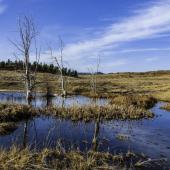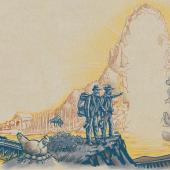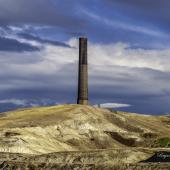Montana in 30 Years: PUBLIC LANDS
Interview with Ray Rasker, Executive Director of Headwaters Economics

“Public Lands” is a term that is often misinterpreted by the public. Can you give us a good working definition?
Public lands belong to all of us, not just to wealthy individuals or corporations. Federal public lands are managed for us by agencies such as the Forest Service, Bureau of Land Management, and the National Park Service. These lands are managed for a wide range of values, from timber and minerals to recreation, as well as for values like scenery, biodiversity conservation, climate adaptation, wildlife, and water. Federal lands make up roughly one-third of Montana’s landscape.
By comparison much of Montana’s state lands are required by law to be managed to turn a profit for the state — which means they are used largely for commercial activities. In Montana, state lands are six percent of the land base.
What are the top three challenges facing Montana’s public lands over the next 30 years?
Climate change tops the list, affecting almost every aspect of the health of public lands, including wildlife habitat, drought, wildfires, and disease, to name a few.
The second biggest threat is the misguided notion that federal public lands should be transferred to the states. This is just a thinly veiled attempt to privatize public lands. States cannot afford to manage these lands (consider just the costs of wildfire suppression) and will sell them to corporations and the wealthy.
The third threat is the high level of use these lands receive. We’re loving them to death a bit, which shows the high demand Montanans place on these lands. Nearly all Montanans — and most of our 11 million annual visitors — use our public lands in some way, whether it’s hiking, biking, bird watching, logging, or mining. Doing so benefits all of us and it’s what makes us Montanans. We live close to the land. But in some places, like the Forest Service lands south of Bozeman, the multiple-use pressure is already palpable, and our population keeps growing.
What do you believe will be the general state of Montana public lands in 2047?
Public lands are a tremendous asset for Montana — and they will increase in value over time. As the world gets more and more crowded, and as farms are overtaken by urban sprawl, Montanans will come to realize that the smartest thing we ever did in this state is to protect our public lands from privatization.
Our federal public lands are key to quality of life. They buffer against sprawl while being large and diverse enough to hold natural processes essential to ecological health like wildfire, nutrient cycling, and water flow. Public lands that are large and interconnected to other public lands, like islands in an archipelago, make it possible for wildlife like elk and antelope to move across vast distances while sheltering magnificent animals like the grizzly bear. The size and diversity of public lands, especially our federal lands, also are critical for the survival of many species in the face of climate change. If we do it right, by 2047 federal public lands in Montana should serve as a model for how protecting nature also protects and benefits our health, economy, and quality of life.
Many would argue that public lands can be put to greater economic use, though differ on what that really means. What do you project those uses to be 30 years from now?
Our federal public lands contribute economically in a number of significant ways. People work on these lands, as ski lift operators, backcountry guides, loggers, ranchers, and miners. Public lands also provide critical services, like water. The outdoor recreation industry, which depends on access to public lands, is huge in Montana, with $5.8 billion in consumer spending, leading to 64,000 direct jobs (about the size of construction and manufacturing combined). Equally important, public lands make our communities attractive places to live and do business. They are our competitive advantage to help attract and keep talent.
So our public lands already have great economic value — and will continue to — if we keep them public and enjoy full access to them. What would greatly degrade these values would be privatizing federal lands, or to manage them for the narrow purposes of turning a short-term profit. That would benefit corporations but would be a great loss for the rest of us. We would lose our scenic views, opportunities to hunt and fish, to experience solitude, wilderness, and the sheer joy of being in nature. We also would lose our heritage and the sense we now have for what it means to be a Montanan, to live close to the land.
Enjoyment of public lands sounds like something everyone can support. But how will such “enjoyment” be affected by increased population and economic demands?
Two things are happening at the same time: there are more people and fewer resources to manage the impacts. People have discovered Montana and are moving here, bringing with them their businesses and retirement dollars. (Retirement money is huge in Montana; twice the size of all personal income earned in farming, mining, oil and gas development and forestry combined.) This in turn stimulates the economy, resulting in more homes, new high-tech firms, and additional hospitals and clinics. This growth also pressures public lands as more and more people go to public lands to “earn that second paycheck from God.”
At the same time, the budgets, staff, and resources of federal land management agencies are shrinking. As a result, the challenges of over-crowding and conflicting uses are going to have to be solved through collaborative efforts with significant citizen participation. We simply no longer can expect federal managers to do everything on their own. Mountain bikers, anglers, hikers, adventure racers, winter fat tire bikers, snowmobilers, and more are realizing that issues like trail maintenance, signage, and education need to be accomplished collaboratively or it won’t get done at all.
What impacts will climate change have on access and use of public lands in the future?
For the long-term, public lands and forests — if properly conserved and managed — will be a major contributor to offsetting and solving the impacts of climate change. These public lands can store immense amounts of carbon and offer the best hope for sustaining the plants, animals, birds, clean air, and clean water so important to Montanans.
In the short term, climate change will directly impact access and enjoyment of public lands. It’s well documented, for example, that the glaciers of Glacier National Park are disappearing. In addition, threats like wildfire, flooding (or lack of water), invasive species, and other stresses will directly impact and alter how, when, and where we are able to enjoy our public lands — whether it’s to hike, float, fish, graze livestock, ski, or hunt.
Wallace Stegner once said that “something would go out of us as a people if we let our last intact landscapes be broken up, degraded, sacrificed or liquidated.” Do you see this as a real threat for Montana public lands over the next 30 years?
I see the degradation of Montana’s landscape as on ongoing threat that in recent years has taken on some urgency by the misguided notion that our public lands should be managed for profit. When some argue that federal lands should be managed by the state for profit maximization, or sold off to corporations and the wealthy, we are being told that the only way to count benefits is by the profits of corporations. But this is a weak view of the economy. Montana’s federal lands inherently hold tremendous economic value.
Today, people decide where to live and do business in large part based on quality of life. Modern telecommunications technology, from video chats to nearby airports, put us in touch with the rest of the world. We can live in Montana, have clients in San Francisco and Boston, but fly fish after work instead of simmering in traffic. That is Montana’s edge. It is how we outcompete compared to a world that has degraded most of its landscapes and wants to turn back the clock (witness the scramble by many cities to reestablish green spaces). Montana is a public lands state, the envy of the nation.
* * * *

Ray Rasker
is the Executive Director of Headwaters Economics, an independent, nonprofit research group. Our mission is to improve community development and land management decisions in the West. Topics include: wildfire; federal payments to counties; energy tax policy; the economic role of public lands; and a number of free analytical tools for helping understand the link between the economy and the environment. Our partners include rural communities, state legislatures, the Forest Service and Bureau of Land Management, universities, and nonprofit organizations.
Ray has a Ph.D. from the College of Forestry (economics), Oregon State University; a Masters of Agriculture from Colorado State University (agricultural marketing); and a Bachelors of Science (wildlife biology) from the University of Washington. Ray also holds an affiliate position at Montana State University.
email: [email protected]
website: http://headwaterseconomics.org












Leave a Comment Here